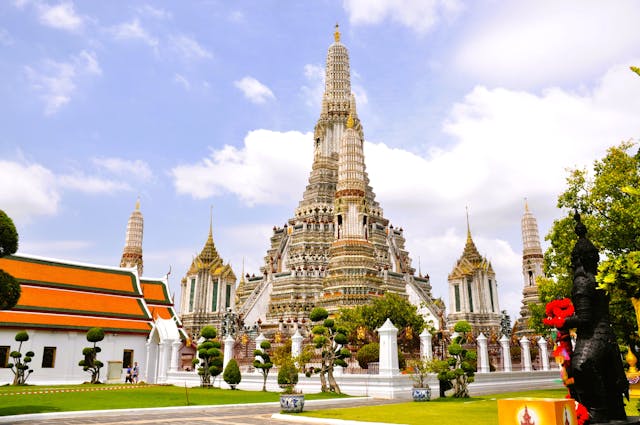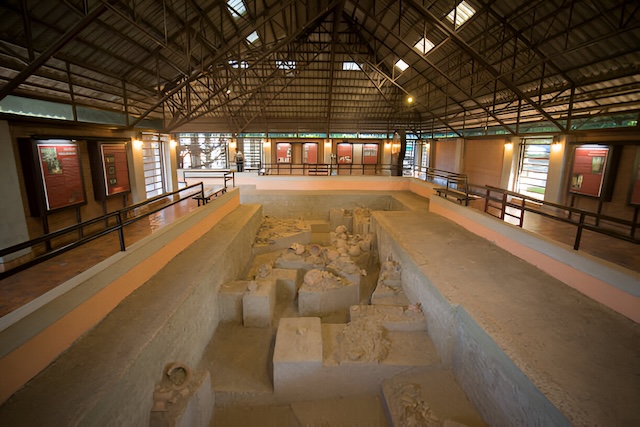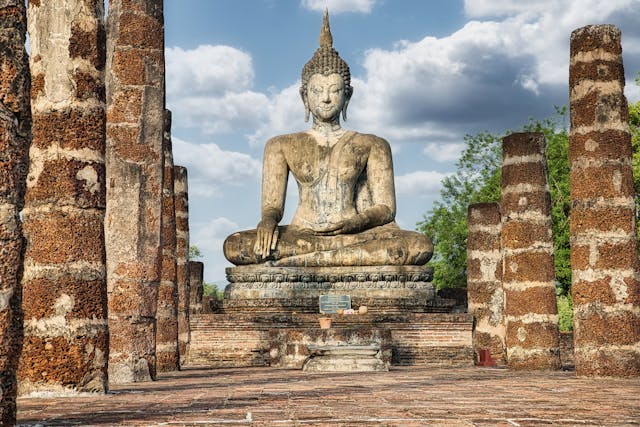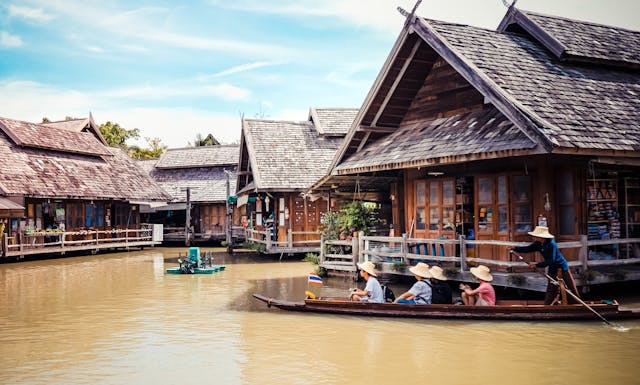History of Thailand is a story of ancient kingdoms, colonial resistance, and vibrant cultural evolution. Formerly known as Siam, Thailand has preserved its independence and cultural identity at the heart of Southeast Asia, navigating centuries of transformation, conflict, and adaptation.
Key Points of the Article:
- Prehistoric origins and Tai migrations
- Founding kingdoms: Sukhothai, Ayutthaya, Lanna
- Thonburi and Rattanakosin periods in detail
- Major historical figures and their impact
- Siam facing colonial powers
- Cold War history and the role of the United States
- Ethnic and religious minorities
- Critical perspectives on monarchy, democracy, and “semi-coloniality”
- Economic and social history
- Recent political transitions and debates
- Cultural influence: gastronomy, arts, festivals
- Population, diversity, and cultural heritage
- Sources and suggested reading
Chronology of Thailand’s History
- ~70,000 BCE: First human remains (Lampang province)
- 5th–11th centuries: Dvaravati civilization
- 9th–13th centuries: Khmer influence
- 1238: Founding of the Sukhothai kingdom
- 1279–1298: Reign of King Ramkhamhaeng
- 1350: Founding of the Ayutthaya kingdom
- 1767: Fall of Ayutthaya to the Burmese
- 1767–1782: Thonburi period (King Taksin)
- 1782: Founding of Bangkok and start of Rattanakosin period (King Rama I)
- 1868–1910: Reign of King Rama V (Chulalongkorn)
- June 24, 1932: Coup d’état, end of absolute monarchy, and adoption of a new constitution
- 1939: Siam officially becomes Thailand
- 1941–1945: Second World War
- 1947–1991: Cold War era, US alliance and military regimes
- 1946–2016: Reign of King Rama IX (Bhumibol Adulyadej)
- 2023: New elections and renewed political instability

From Prehistory to the Arrival of the Thais
The earliest traces of human presence in Thailand date back nearly 70,000 years, with archaeological sites like Ban Chiang (UNESCO) attesting to the region’s prehistoric roots. From the 5th century, the Dvaravati and Khmer civilizations shaped the central and northeastern plains, introducing Buddhism, art, and early urbanization, before the arrival of Tai-speaking peoples from southern China.
| Name | Period | Area of Influence | Heritage |
|---|---|---|---|
| Dvaravati | 5th–11th centuries | Central | Buddhism, art, script |
| Khmer Empire | 9th–13th centuries | Northeast, Central | Architecture, administration |

The Great Kingdoms: Sukhothai, Ayutthaya, Lanna
The 13th century marked the rise of Sukhothai, often considered the cradle of Thai identity. Sukhothai’s kings promoted the Thai script and Theravada Buddhism. In the north, the Lanna kingdom flourished around Chiang Mai, while Ayutthaya became the dominant power from 1350, ruling for over 400 years and engaging in trade with China, India, and Europe. These kingdoms laid the foundations for Thai culture, language, and political organization, with Sukhothai’s influence extending as far as the Malay Peninsula.
- Sukhothai (1238–1438): Thai script, Theravada Buddhism
- Lanna (1292–1774): Northern kingdom, capital Chiang Mai
- Ayutthaya (1350–1767): Cultural peak, international trade

Thonburi and Rattanakosin Periods in Detail
Thonburi Period (1767–1782)
After Ayutthaya’s destruction in 1767, General Taksin reunified the fragmented Siamese lands and established his capital at Thonburi, near present-day Bangkok. The Thonburi Kingdom saw rapid military expansion and the incorporation of neighboring states (Lanna, Lao kingdoms, Cambodia) under Siamese influence. Taksin encouraged Chinese trade and migration, strengthening the economy and multicultural fabric of the kingdom. His reign ended in 1782 after internal strife, paving the way for the Rattanakosin era.
Rattanakosin Period (from 1782)
Chao Phraya Chakri, a leading general, became King Rama I and moved the capital to Rattanakosin (Bangkok), founding the current Chakri dynasty. The early Rattanakosin era restored Ayutthaya’s cultural and political systems, built iconic temples and palaces, and expanded Siam’s territory. Bangkok’s strategic location fostered trade and diplomatic ties, setting the stage for modernization in the 19th century.
Major Historical Figures
- Ramkhamhaeng (1239–1317): King of Sukhothai, credited with creating the Thai script and championing Theravada Buddhism. His reign is often seen as a golden era of paternal and benevolent kingship, shaping the foundations of Thai identity.
- Taksin (1734–1782): Military leader who reunified Siam after Ayutthaya’s fall, established Thonburi as the capital, and revitalized the kingdom’s economy and army. His legacy is complex, marked by both expansion and controversy.
- Rama I (1737–1809): Founder of the Rattanakosin era and the Chakri dynasty, he rebuilt the capital at Bangkok and restored many cultural and political traditions, laying the groundwork for modern Thailand.
- Rama V (Chulalongkorn, 1868–1910): Visionary reformer who abolished slavery, modernized administration, and protected Siam’s sovereignty through strategic diplomacy and adaptation to global changes.
- Rama IX (Bhumibol Adulyadej, 1946–2016): The world’s longest-reigning monarch, revered for his rural development projects and for embodying national unity during decades of social and political change.
Siam Facing Colonial Powers
In the nineteenth and early twentieth centuries, Siam navigated the ambitions of European empires—especially Britain and France—by engaging in diplomatic negotiations and making calculated territorial concessions. This strategy allowed Siam to remain the only Southeast Asian nation never formally colonized, although Western economic and legal influences became deeply embedded in the country’s institutions. The concept of “semi-coloniality” is sometimes used to describe this unique position, where formal independence masked significant external pressures.
| Country | Colonizer | Period of Colonization | Current Status |
|---|---|---|---|
| Thailand (Siam) | None | Never colonized | Independent |
| Vietnam | France | 1858–1954 | Independent |
| Laos | France | 1893–1953 | Independent |
| Cambodia | France | 1863–1953 | Independent |
| Burma (Myanmar) | United Kingdom | 1824–1948 | Independent |
During World War II, Thailand’s territory and infrastructure were dramatically affected, notably with the construction of the infamous Death Railway and the Bridge on the River Kwai. This episode remains one of the most significant and tragic in the country’s modern history.
To learn more about this pivotal chapter and its legacy, read our Bridge on the River Kwai Guide.
Cold War Era and the United States
Throughout the Cold War, Thailand aligned itself with the United States, receiving substantial military and economic assistance in exchange for supporting anti-communist efforts in the region. This alliance reinforced the power of the military and fostered a series of authoritarian governments, particularly in the northeast. The era left a lasting imprint on Thailand’s political landscape, institutionalizing cycles of coups and limiting the development of stable democracy.
Ethnic and Religious Minorities
Thailand is home to a remarkable diversity of peoples, with over 70 ethnic groups including Thai, Lao/Isan, Chinese, Malay Muslims, Khmer, and numerous hill tribes such as the Akha, Hmong, Karen, Lahu, Lisu, and Mein. While Theravada Buddhism is the state religion and shapes much of the national culture, Islam, Christianity, Hinduism, and animist beliefs are also practiced. Government policies have often promoted assimilation, which has sometimes marginalized the languages and cultures of minority populations, especially in the northeast and the far south.
Critical Perspectives: Monarchy, Democracy, and “Semi-Coloniality”
The Thai monarchy remains a powerful symbol and institution, but its political role is the subject of ongoing debate. Since the 1932 revolution, Thailand has oscillated between periods of parliamentary democracy and military rule, with the monarchy often positioned as a stabilizing force. The term “Thai-style democracy” refers to this hybrid system, where military, royal, and elite interests frequently outweigh popular sovereignty. Some historians argue that Thailand’s independence masked a form of “semi-coloniality,” as Western powers and domestic elites shaped the nation’s laws, economy, and political order.
Economic and Social History
Thailand’s economic journey spans from ancient trade centers like Ayutthaya and Bangkok to its current status as a major rice exporter and manufacturing hub. The abolition of slavery and encouragement of Chinese entrepreneurship under Rama V set the stage for modernization. The twentieth century brought rapid urbanization, industrial growth, and deeper integration with the global economy. Yet, stark inequalities between urban and rural areas, as well as between regions, continue to challenge social cohesion.
Recent Political Transitions and Debates
Since the early 2000s, Thailand has faced a turbulent political climate, marked by frequent coups, mass protests, and constitutional crises. The military and monarchy continue to exert significant influence, sometimes at the expense of elected governments. The 2023 elections and the return of the Shinawatra family to power have once again highlighted the fragility of Thailand’s democracy, with party dissolutions and court interventions shaping the nation’s political future.
Cultural Influence: Gastronomy, Arts, and National Festivals
Thai culture is celebrated for its diversity and sophistication. The cuisine is a fusion of Indian, Chinese, Malay, and Western influences, offering dishes like Pad Thai, Som Tam, Massaman curry, and mango sticky rice.
To truly immerse yourself in this rich cultural tapestry, from enjoying a traditional meal to participating in a vibrant festival, understanding the local Thai etiquette and customs is key. If you want to discover how Pad Thai became a symbol of national identity and modernization in the 20th century, read our history of Pad Thai.
Traditional arts—including classical dance, shadow puppetry, wood carving, and temple murals—remain vibrant. Major festivals such as Songkran (New Year), Loy Krathong (festival of lights), and the King’s Birthday are central to the country’s social calendar.
- Gastronomy: Pad Thai, Som Tam, Massaman curry, mango sticky rice
- Arts and Crafts: Khon dance, wood carving, temple murals, fruit sculpture
- National Festivals: Songkran, Loy Krathong, National Day (December 5)
Population, Diversity, and Cultural Heritage
Thailand’s population approaches 70 million, with a rich tapestry of ethnicities including Thai, Sino-Thai, Khmer, Mon, Malay, and many hill tribes. This diversity is reflected in languages, culinary traditions, and regional customs. The elephant is an enduring national symbol, and despite efforts at centralization, local and regional identities remain strong.
To learn more about the historical and cultural importance of elephants in Thailand, read our dedicated article on elephants in Thailand.
- Official language: Thai
- Capital: Bangkok (Krung Thep)
- Area: 513,120 km²
- Flag: red, white, blue

Further Reading: Suggested Resources
- Si Phaendin by Kukrit Pramoj: A historical novel covering four generations of Thais, ideal for understanding the country’s changes in the 20th century.
- Kham Phiphaksa by Chart Korbjitti: A contemporary novel about justice and Thai society.
- Phai Daeng by M.R. Kukrit Pramoj: A political and social satire of the 20th century.
For an official and comprehensive overview, see the History & Geography page of the Tourism Authority of Thailand.
Conclusion: A Country with a Unique History
The history of Thailand is that of a resilient people, proud of their independence and culture. From ancient kingdoms to the modern nation, the country has preserved its identity while opening up to the world. For travelers and expatriates, understanding this past means better appreciating the richness of today’s Thailand.
To truly connect with this rich history and culture, one of the best ways is to learn the Thai language.
FAQ on the History of Thailand
What was Thailand’s former name?
The country was called Siam until 1939, and briefly from 1945 to 1949.
Why was Thailand never colonized?
Thanks to skillful diplomacy and territorial concessions, Siam preserved its independence.
What are the founding kingdoms?
Sukhothai, Lanna, and Ayutthaya are the main kingdoms at the origin of Thai identity.
What is the role of the monarchy today?
The Thai monarchy, highly respected, embodies national unity and historical continuity, but its political role is debated.
What is the capital of Thailand?
The capital is Bangkok, called Krung Thep in Thai.
What are the typical dishes of Thailand?
Pad Thai, Som Tam, green curry, Massaman, mango sticky rice.
What are the most important festivals?
Songkran (New Year), Loy Krathong (festival of lights), National Day on December 5.
How diverse is Thailand’s population?
Thailand is home to over 70 ethnic groups and several religions, reflecting its complex history of integration and migration.
How did the Cold War affect Thailand?
The US alliance shaped Thai politics, supporting military regimes and influencing the country’s institutions.
🔄 Last updated on July 3, 2025
